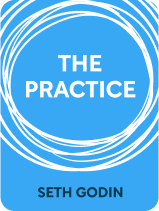

This article is an excerpt from the Shortform book guide to "The Practice" by Seth Godin. Shortform has the world's best summaries and analyses of books you should be reading.
Like this article? Sign up for a free trial here.
What is creative time management? How much time should you spend on a creative project?
In The Practice, Seth Godin says that time management is extremely important for creative people. By setting aside a specific time of day for your project, obstacles won’t slow you down.
Let’s look at creative time management in practice.
Work Consistently Despite Obstacles
While trusting yourself and establishing your intent are important to creative work, perhaps the most critical aspect of being a creative professional is creative time management, or working consistently despite the challenges that come your way. Godin advises that you spend at least an hour every day on your creative work. He takes the position that many of the apparent obstacles to producing good work—lack of inspiration, failure, and creative “blocks,” to name a few—are actually integral to your practice (or at the very least, they’re not the threat they’re often made out to be).
Inspiration Follows Work
Creatives often speak of being “touched by the muse” or working in a state of flow. Indeed, there are times when it feels like magic infiltrates your work and genius flows through you. When you aren’t inspired in this way, it can be hard to make progress, and everything you create feels flat and boring. It might seem like you only have two choices: Produce low-quality work, or give up for the day until inspiration returns.
But Godin says that letting yourself feel this way is a form of giving up your own agency. The truth is that inspiration shows up when you put in the work. You don’t create because you’re inspired; you’re inspired because you create. Rather than waiting for inspiration to arise or for conditions to be perfect, simply do the work to allow inspiration the opportunity to arise. Plus, while working when you’re not inspired can be challenging, Godin points to research showing that you’re more likely to improve if a task is difficult for you. When you’re trying to get better at something, you’re necessarily going to feel incompetent before you get there. So while you’re often going to feel incompetent while you’re creating, if you don’t challenge yourself, you can’t improve.
Failure Is Necessary to Succeed
Every time you do creative work, you’re making something for the first time: You may have written songs before, but you’ve never written this particular song; you’ve never painted this painting or written this story. And the only way to do something new, Godin says, is to be willing to fail.
Anyone who creates regularly has failed many times. Even successful directors make unsuccessful movies, and famous bands make bad songs.
Failure is the foundation of creative work. You fail, then you make changes and try again. As long as you don’t stop, failure always leads to improvement.
Creative “Blocks”
Godin maintains that “writer’s block,” or any kind of creative block, isn’t real. Rather, it’s a story we tell ourselves. For example, we might think, “I’m not Toni Morrison (or Mick Jagger, Renoir, Beyonce, or any other iconic artist). I don’t have the time, the talent, or the luxury to sit around and create art. I can’t keep staring at this blank page, I have to do the laundry.”
We all have a story about who we are and what we are (or aren’t) capable of. However, rather than accept the story you tell yourself at face value, you have to ask yourself two questions, says Godin. First, does the story accurately reflect reality? (Is there reason to expect that you would be as good as a Pulitzer prize-winning author when you’re first starting out?)
Second, is your story helping you achieve your goals? (What matters more to you in the long run, the laundry or your long-neglected creative endeavor?) Godin claims that if the story you tell yourself isn’t working for you, then you can change it. This is much easier than trying to change reality to fit your narrative. For example, you might tell yourself, “I’m still relatively new to this, and, like any other skill, I’ll need to practice more before I learn how to do it well. If I invest a small amount of time every day, I’ll learn to trust myself and I’ll create something I’m proud of.”
One benefit of time management for creatives is that you’re working every day and constantly moving forward, so it’s harder to get “blocked.” You create regardless of whether you want to or not, and regardless of whether you’re inspired. It’s better to create something that’s not great and work to improve it than it is to say you’re stuck and not create anything at all.
Very few people create brilliant work from the start, according to Godin. All work is bad at first.
In fact, sharing “bad” work or ideas is essential to creating good work. Sharing work that’s not good shows you that you can survive it and learn from it. (“Good” is very hard to define in any event, says Godin. Many best-selling books and movies were rejected repeatedly before they found success.)
Sunk Costs
While you shouldn’t give up on creative work just because of a temporary “block,” or lack of creative time management there are times when giving up is appropriate. If you’ve invested a lot of time and effort into something that’s not working, you don’t have to stick with it. According to Godin, feeling regret about sunk costs is better than sticking with something that isn’t going anywhere. For example, if you’ve revised a short story many times and you can’t get it to where you want it, it’s OK to abandon it and move on to something new. Maybe the story would make more sense as a novel (in which case, it wasn’t a waste of time to consider some of the characters and plot points in a shorter draft).
(Shortform note: The pull to stick with something just because you’ve invested time, effort, and money into it is well-documented in a variety of fields. For example, one 2018 study found that, given a chance to win money using either a solution they’d developed or a solution with a higher probability of winning, the majority of participants chose the sunk-costs solution. This was likely due to a psychological need to feel that their work hadn’t been in vain, as well as a need to feel competent in their decision-making.)

———End of Preview———
Like what you just read? Read the rest of the world's best book summary and analysis of Seth Godin's "The Practice" at Shortform.
Here's what you'll find in our full The Practice summary:
- Why creativity doesn't require any “magic”
- How creativity is a skill that anybody can learn
- Step-by-step lessons on how to be creative






